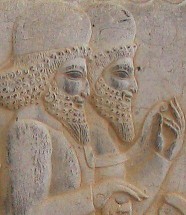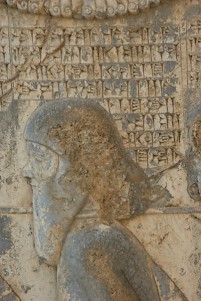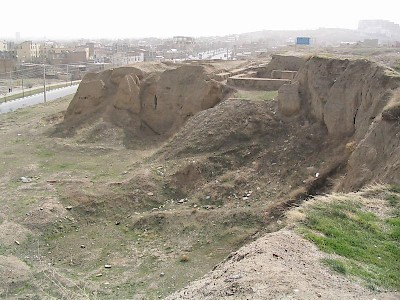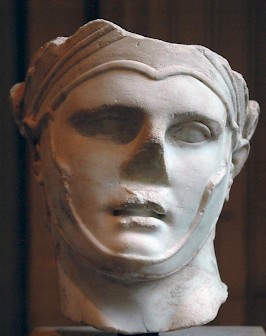Medes (2)
Medes (Old Persian Mâda): tribe, ruled by a king, in the west of modern Iran; capital Ecbatana (modern Hamadan).
The evidence from Daniel

In the Biblical book Daniel, we encounter a famous summary of the history of the ancient Near East: the vision of the four beasts (text), which all represent an eastern monarchy that dominated the sacred city of Babylon.
- The lion with eagle's wings: the Babylonian empire (which existed until 539 BCE). The image is well chosen, because animals like these were depicted in Babylonian art.
- The bear: the Median empire.
- The four-headed leopard with fowl's wings: the Achaemenid empire (539-330).
- The ten-horned beast with iron teeth: the empire of Alexander the Great (336-323). Alexander was often depicted with the ram's horns of his divine father Ammon.
There is little doubt about this interpretation, but there is one problem: the Medes were only an important world empire in the Histories of Herodotus of Halicarnassus, who is also the first author to ignored the difference between Assyria and Babylonia. Elsewhere, the author of Daniel makes a king with the strange name "Darius the Mede" conquer Babylon. As we have already seen, the "real" Medes were a tribal federation and never captured Babylon. It is very likely that the author of Daniel, who wrote in c.165 BCE, was influenced by the Greek view of history, and gave the Medes more importance than they deserved.
Media in the Behistun Inscription
However this may be, after 550/549 Media was part of the empire of Cyrus the Great. There must have been resentments against the new rulers, and the Medes revolted when Cyrus' son and successor Cambyses had died in 522. He was succeeded by his brother Bardiya, the Smerdis of the Greek sources, who announced that the provinces were for three years released from their obligation to pay tribute and took the Median citadel Sikayauvatiš as his residence.
This caused great indignation among the Persian elite, and a distant relative of Bardiya named Darius, together with six conspirators, assassinated the new king. Darius' own story can be read in the Behistun inscription and is also known from Herodotus' Histories. Both men agree that the man who had been killed was not the lawful ruler Bardiya, but his double, a Magian named Gaumâta. As the "Magians" were not only a group of religious specialists, but also a Median tribe, and the killed man's policy seemed to favor Media, Darius may be right.

Whatever Bardiya/Gaumâta's identity, his death meant the beginning of several revolts. In Babylonia, a man named Nidintu-Bêl proclaimed himself king, and when Darius had gone to Babylon, a new rebel leader stood up in Media, Phraortes, who descended from one of the Median kings of old, Cyaxares, and gained support in Sagartia, Parthia and Hyrcania. There were also insurrections in Armenia, Elam, and Persis.
It looked like a formidable revolt, but Phraortes was defeated by the Persian general Hydarnes on 12 January 521. It was not a decisive Persian victory, however, and Phraortes managed to stand his ground during the winter, until Darius took charge of the war personally: on 8 May, he defeated the Medians near Kunduruš, which seems to have been the ancient name of modern Kangavar. The Persian victory was complete, and while Darius sacked Ecbatana, Phraortes fled to Rhagae (modern Tehrân), where he was intercepted; the rebel king was crucified in his former capital.
A Sagartian named Tritantaechmes, who also claimed to descend from the Median leader Cyaxares continued the rebellion, but was defeated by Darius' Median general Takhmaspâda. This rebel was crucified in Arbela.
This was the end of the latest Median insurrection. It seems that the Medes now acquiesced in the rule of their Persian overlord. They had a special position in the Achaemenid Empire, belonging to the elite. Ecbatana was one of Darius' residences, and in another capital, Persepolis, the Medes are often depicted as equals of the Persians. In the Biblical book Esther, the two nations are juxtaposed in the famous expression "laws of Medes and Persians". In Greek, the names of the two Iranian nations were used as synonyms: the conflict we know as "Persian war", was known to the Greeks as "Median war".
Later history
In the first years after the coup of Darius, the Persian general Hydarnes was satrap of Media. After this, the country more or less disappears from sight. The cuneiform archives of Babylon are less informative after 484 (which may have something to do with the repression of the revolt of Šamaš-eriba); there are no Assyrian archives; the Persepolis fortification tablets do not reach beyond 493; Herodotus' story ends in 479; other Greek authors (e.g., Ctesias of Cnidus, Xenophon) ignored Media; and -finally- of all Achaemenid kings,only Darius left a historical inscription.

Archaeological research is not easy, too. We know that Ecbatana was an important city in the Persian age, but not many excavations have been conducted. The Achaemenid kings Darius II Nothus (424-404) and Artaxerxes II Mnemon (404-358) have left inscriptions that prove that they were interested in this residence, but this is about everything we know.
Media becomes visible again during the war between the Macedonian king Alexander the Great and his ill-fated Persian opponent Darius III Codomannus. After the latter's defeat at Gaugamela (331), he tried to reassemble an army at Ecbatana, but in the spring of 330, he was forced to retreat to the east, and was murdered. Alexander initially left control of Media, which was strategically important as it controlled the Macedonian lines of contact, to his trusted general Parmenion, who, however, was assassinated when Alexander became suspicious of his son Philotas.
It is known that Parmenion and -later- two other Macedonian officers, Sitalces and Cleander, attacked native Zoroastrian sanctuaries. In 325, a local leader named Baryaxes revolted against the new rulers, but his rebellion was suppressed by Alexander's satrap of Media, Atropates. To restore order, he also had to charge the two officers, who were indeed convicted by Alexander and eventually executed.
After the death of Alexander in 323, Atropates was removed from office and replaced by a man named Peithon, but he was able to keep the northern part of Media, which was called Atropatene. (Today, Atropates' name lives on in the name Âzarbayjân, a province in the north of modern Iran that is not to be confused with the former Soviet republic with the same name.) Media Atropatene became one of the main centers of Zoroastrianism.

After the wars of the Diadochi, Media became part of the empire of Seleucus I Nicator, which included parts of Anatolia and Syria, all of Mesopotamia, and the Iranian platform. This meant that Media contined to be of the greatest importance: it was quite simply the heart of the Seleucid Empire, as it had been the core of the Achaemenid empire. There are monuments from this period along the Silk Road (like the charming reclining Heracles at Behistun) and elsewhere.
In the course of the second half of the third century, the Parni nomads began to infiltrate Parthia, east of Media, and started to act increasingly independently, calling themselves after the region they had just conquered. The Parthian king Mithradates I the Great (r.165-132) was able to conquer Media and, having gained this strategically important satrapy, crossed the Zagros and proceeded to conquer all of Mesopotamia.
For centuries, Media was the center of the Parthian Empire: even though its capitals were at Hecatompylos in Parthia and Ctesiphon in Mesopotamia, the kings always had to pass through Media, and we know of Parthian building activities at Ecbatana. Other monuments are known from Kangavar nd Behistun.